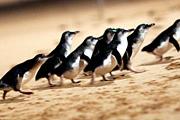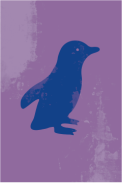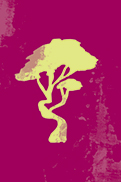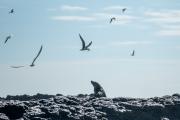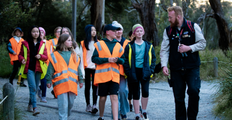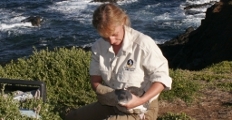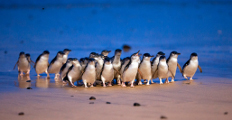Australian first sailing drone ready to explore penguin feeding grounds
Australian first sailing drone ready to explore penguin feeding grounds
Researchers at Phillip Island Nature Parks will have a clear picture of the underwater world of the Little Penguin, thanks to a new, high-tech, sailing drone on loan from the French National Centre for Scientific Research (CNRS), which will help map the penguin foraging grounds for the first time.
The sailing drone will survey the waters off Phillip Island, collecting vital information on water temperature, fish abundance and salinity. It sends sound to the bottom of the ocean, and the echo is translated into images, which will be used by scientists in future research.
The two-metre-long sailing drone, acquired by the lead scientist of the project, Dr Claire Saraux from CNRS, is the result of a partnership between Phillip Island Nature Parks, CNRS, the Swedish University of Agricultural Sciences and the Penguin Foundation. It is fitted with an echo-sounder to give a live picture of what predators and prey lie under the water.
Phillip Island Nature Parks’ Marine Scientist Associate Professor Andre Chiaradia said information collected by the sailing drone will be an invaluable asset for penguin research now and future studies into the health of the marine environment around Phillip Island.
“There is a need to improve our knowledge of penguins and other marine species. The sailing drone will give us crucial information for marine spatial planning and conservation,” he said.
“This is an exciting project for us. It’s technology we haven’t had access to before, and it will change how we manage research and conservation projects for our penguin population.”
“We do not have accurate information on prey composition and availability in the marine systems because direct prey data collection is difficult and expensive, usually requiring research vessels with the prohibitive cost of shipping time.”
The sailing drone sets out to solve these problems. It is an autonomous drone, powered by wind and currents to sail and solar panels to steer and power the sensors.
Dr Claire Saraux from the French National Centre for Scientific Research is the principal investigator in the sailing drone project.
“The drone will autonomously collect data during several breeding seasons, giving us insights on environmental variability over time and crucial information to help us manage the food supply of little penguins in the future.” she said.
Associate Professor Jonas Hentati-Sundberg from the Swedish University of Agricultural Sciences is a partner on the project.
“By using green energy, the sailing drone will survey, for the first time, the foraging areas of little penguins on Phillip Island. The drone is equipped with several high-resolution environmental sensors and will collect data on water temperature, salinity, and chlorophyll,” he said.
French PhD student Lilia Guillet will operate the drone as part of her studies.
“Not only will we see the different types of fish under the water, we will also see the quantity of fish. This can help scientists to know what food is available in the foraging zone of little penguins,” Ms Guillet said.
The sailing drone will collect data and information for three years.





